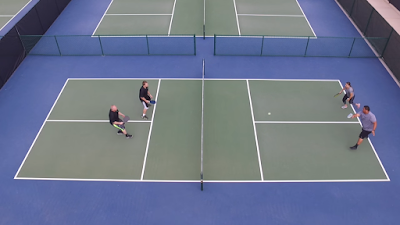Everything has a purpose...
 Everybody talks a lot about the third shot drop...and they should. After all, it is one of the most important shots in any rally. But what makes it so important? I want to discuss what makes a third shot drop effective but we must first make clear its purpose before effectiveness can be determined.
Everybody talks a lot about the third shot drop...and they should. After all, it is one of the most important shots in any rally. But what makes it so important? I want to discuss what makes a third shot drop effective but we must first make clear its purpose before effectiveness can be determined.
Prior to any discussion, let's ensure that we are all on the same page with regard to the court positions and advantages or disadvantages at play on the third shot. The third shot is hit by the serving team immediately off the return of serve made by their opponents. The serving team must wait for the return of serve to bounce before making a play. This normally allows their opponents to be positioned at the NVZ while the serving team remains stuck in the back of their court. This is pictured below. The gray (serving) team is back while the black (receiving) team is up near the NVZ.
We know that rallies have a much higher likelihood of being won by the team at the NVZ. Therefore, the gray team is at a significant disadvantage, as is any serving team. The third shot is so important because it should start the process of narrowing the advantage-disadvantage differential.
The perfect third shot (or any shot) would be a winner. That eliminates the disadvantage in the best way possible - a point for the serving team. But an outright winner is difficult from such a disadvantageous position. Therefore, we need to look for a different measure to evaluate a third shot's effectiveness.
Many folks, including me, have said that the third shot's purpose is to allow the serving team to get to the NVZ and improve from disadvantage to a neutral position. Several shots can serve that purpose. A lob provides plenty of time for the team to advance. A drive can even be followed with rush to the net. But are they effective? Rarely. Both can be smashed back because they are attackable balls. As discussed in the post Attackable, providing a ball above the net to your opponents is generally a big mistake.
Instead of focusing on just providing time to get to the NVZ, the effectiveness of the third shot must include a determination of its attackability. An effective third shot allows the serving team to get to the NVZ while forcing their opponents into hitting a defensive shot. The shot that accomplishes both of these goals on a consistent basis is a third shot drop.
But an effective third shot drop is also more than a shot that just lands in the NVZ. A drop that bounces above net height is attackable. Even a drop that remains just below net height but bounces near the NVZ line is attackable. A drop must be unattackable - meaning the opponents must be forced to hit the ball up - to be considered a success. This means that at least one of two elements must be in place - a low bounce or a bounce that lands close to the net.
The effectiveness of a likely low-bounce drop can be diminished, though, if it can be reached before bouncing. A long-limbed player can hit a dropping ball at a point high enough relative to the net to semi-drive a topspin shot over the net. In this case, the target for an effective shot has shrunk and is much less than the 7 foot depth of the NVZ.
A shorter ball taken in the air from a low position can also be a problem. It can be dropped and angled to force the serving team to make a difficult shot. Taking the ball in the air gives the serving team much less time to move from the baseline to get to the ball. This means the serving team has less time to assess whether the drop shot is good enough to advance. After getting beaten by the drop volley, the servers will start to come in more frequently - even when the third shot drop might warrant staying back.
So what is the bottom line for an effective third shot - one that allows the serving team to get to the NVZ and forces their opponents to hit a defensive shot? The third shot drop must:
- Land in the NVZ
- Land far enough from the opponent so that he cannot hit a volley
- Bounce below the level of the net
- Bounce lower as it hits farther from the net and closer to the NVZ line
I have often said that the third shot drop is the most difficult part of the game. Now you know why. The target area for maximum effectiveness is very small.




No comments:
Post a Comment